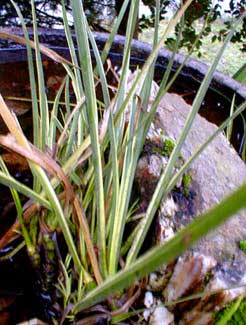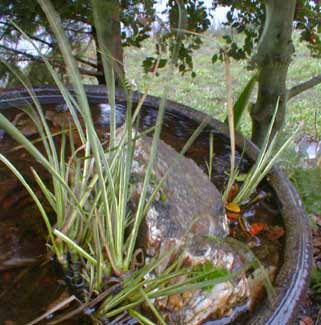
Variegated Dwarf Sweet Flag;
aka: Japanese Rush,
White-Striped Sweetflag,
Grass-leaved Sweet-flag,
Silver Variegated Calamus
Japanese Rush, or variegated dwarf sweet flag (Acorus gramineus variegatus), is a clump-forming grassy bog-plant that likes to have its root crown just below the water. A fragment of a clump had been pulled out of a bog-planter by a racoon & left in the middle of the lawn. I picked it up & put in the birdbath so it wouldn't dry out. I sat a rock on the root so it wouldn't get knocked out of the birdbath.
In these December photos it's a little scruffy partly from it being winter & more because it isn't actually properly planted. Every time I think of finding it a more suitable spot, I always think I kind of like it in the birdbath & surprised it's done as well as it has without its roots in muddy soil to sustain it. Birds like to land on the rock & feel sheltered by the grass. I suppose enough fallen leaves & bird-poops get in the water to get the sweetflag the nutrients it requires.
It will also thrive in frog or salamander terrariums. As aquarium plants per se, they decline extremely slowly even though unhappily submerged, so it is used by some as a submersible aquatic plant despite that it will eventually die. If planted in a shallow tank, though, so it can grow partly out of the water, it'll spread & grow very nicely.
This stuff is very hardy here in zone 8, & at least eighty-percent evergreen through winter. It's not awfully cold or heat hardy, however, & much more of it would die back in zone 5 & 6 winters, & it would be scorched & homely in zones 9 or 10.
Being evergreen gives it a point ahead of most bog plants, the majority of which die back in winter. The grassy leaves are striped pale green & off-white, & is grown exclusively for the grassy foliage, which occasionally rises from the long rhizomes as a series of open fans rather than a round clump. It grows eight to twelve inches tall.
 It does flowers in summer, a little yellowish brown spike of no consequence. The insignificant flowers produce an equally insignificant teency-tiny cob of berries, a bit interesting if one likes to peer at the garden through a magnifying glass.
It does flowers in summer, a little yellowish brown spike of no consequence. The insignificant flowers produce an equally insignificant teency-tiny cob of berries, a bit interesting if one likes to peer at the garden through a magnifying glass.For drama almost anything else would be better, but it is a perfect year-round substitute for small ornamental grasses in any location that is mildly wet to boggy.
It doesn't absolutely require a bog & will do well in merely moderately moist soil, but might require a little shade in well-drained areas so that it is less apt to entirely dry out. Drying out occasionally doesn't seem to bother the tough leaves much, but too much summer sun or protracted dry conditions will definitely cause it to look poorly. In too much shade it will just stop growing, lingering but stunted. When its root-crown is submerged, it likes best bright sun, though the further south it is tried the more it may require a degree of protective afternoon shade.
Though it looks like grass or a primitive iris, it is in reality an aroid, a close relative of jack-in-the-pulpits. But its spathe is so reduced as to pass unseen, & the flowering spadix gives no novel impression, looking more like stems of sedge blooms & nothing at all like hooded arums or pulpits.
The clumps can be divided autumn for cold frames or greenhouses, but ideally in late winter or in early spring before new growth begins. In spring it restarts with great ease from even a small piece of the woody rhizome.
It is called "sweet" flag because of a cinnamony fragrance when leaves are buised. Leaves of the cultivar named "Licorice" smells of anise. In old traditional Japanese houses, the leaves were scattered just inside doorways on a dirt floor in front of the raised wood & tatami flooring, to release the pleasant scent when visitors first arrive & traipse on the strewn leaves before removing their shoes.
The volatile oils when steam-extracted are sufficiently concentrated to be toxic or carcinogenic, but the intact root has long been used for millennia in Asia & India as a ginger-like sweet-scented condiment without side-effects. The root can be peeled, cut into small cubes, soaked for an afternoon in consecutive baths of water to leech away any bitterness; then grated to use raw with sushi rice or other dishes. It can be wok-fried with veggies & noodles, being less gingery when cooked. It can also be dried for later use. Dehydrating strengthens its flavor & pungency. It can be pulverized to be used as a powdered spice, but should not be pulverized until immediately before use. Two-year-old roots are best, as older roots become increasingly woody, ropy, & hollow.
The only two species within the genus Acornus have both been used medicinally at all parts of the globe, but after concentrated extracts were proven to be cancer-causing, they were removed from the Federal Drug Administration's list of legal pharmaceuticals & have not been legally available as medicines since the 1950s, which is not to say no one offers it even so. The root is still used medicinally in China, India, & the Philippines, & sometimes marketed by western importers as Asian Calamus Root or by its Chinese name Shi Chang Pu, despite that preparations for internal use are illegal in the U.S.
The only other Acornus species is A. calamus native of the norther nhemisphere. Its root extracts are commonly used as a topical ointment or perfume base, & for centuries served Europeans some of the same medicinal uses (or randomly different uses, such as for the common cold or bronchitis) as has A. gramineus throughout Asia.
Some of its uses for Japanese Sweetflag are merely mystical, as for example when Thai Buddhist herbalists recommend it for "awareness blockage" to assist the mind in achieving nirvana. This is almost certainly related to the fact that the extracts in concentration can be hallucinogenic. Its Asian use for liver disease does not likely have any basis to it beyond theories of Ki or Kundalini energy & an ancient belief that consciousness is in the liver. With modern knowledge that consciousness is seated in the brain, herbalists have been less inclined to recommend sweetflag extract for liver ailments, & allege instead that it is useful for treatment of Alzheimer's disease & brain injury. On the off-chance that there really is some chemical component in Acornus species that could effect cognition, it has been subjected to a few controlled studies, without hopeful outcomes.
Extract of A. gramineus has many additional claims made for it, including the Chinese belief that it heightens sexual desire. Although its use as a sex-drug is dubious to a high degree, it does produce chemical compounds that are antiseptic, analgesic, & known to be nervous system stimulants, & like stronger hallucinogens can temporarily alter perception. It is known to have been used as a douche to abort unwanted pregnancies, & I have seen this extended to one thoroughly quack advertisement that it would work as a "morning after pill" to stop pregnancy after unprotected sex.
It has many other folk uses & some of them may even have some basis of truth, but by recommending it for everything under the sun no specific value can seriously be deduced. One of the more intriguing uses of Japanese Sweetflag is for the manufacture of a Korean alcoholic beverage called Liquor of the Immortals, having effects similar to those of absinthe. Because of such holy & shamanic contexts for this herb, it is believed by some to be alluded to in Exodus 30: 23-25 as a component of the recipe for sacred annointing oil, although this is neither provable nor particularly likely.